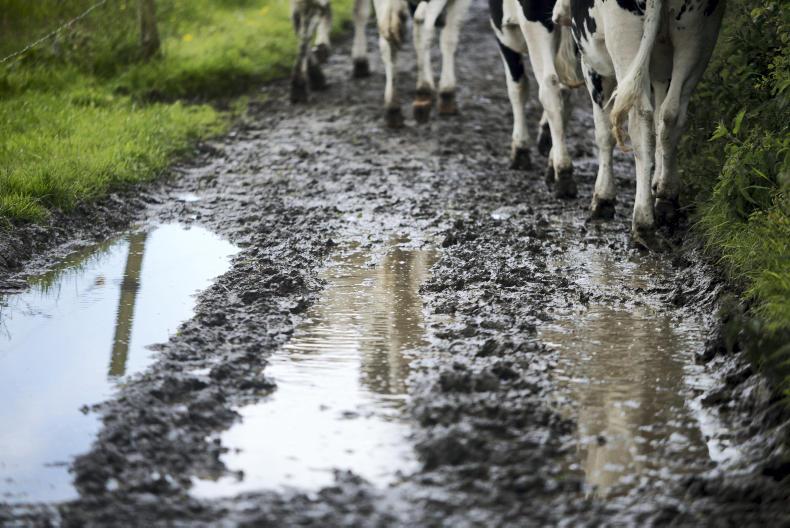As we go to press, indications are that most dairy co-ops will increase milk prices for May by at least 1c/l. Coming as production peaks, the move will boost the May cheque by the equivalent of €10m. Compared with 2016, the stronger market has effectively boosted the value of milk produced on Irish dairy farms during May by €75m-€80m this year. It is a welcome development but one that merely reflects the level of financial pressures felt in 2016.
It is understandable, therefore, that farmers trying to bring finances back into line are anxious to ensure that co-ops pass the full market value back in the milk price – particularly during peak production. This price focus is understandable given that each 1c/l affects the monthly milk cheque during the May-July period by the equivalent of €3,500 to €4,000 for a typical dairy farmer.
It is widely recognised that a rapid recovery in the butter market, driven by strong demand and depleted stocks, helped boost global trade throughout the first quarter – even if an overhang of skimmed milk powder (SMP) has limited the scope for a milk price response.
However, in recent weeks we have seen some life injected back into the SMP market, particularly for fresh product.
Two factors are at play. The most significant is the realisation that the European Commission is determined not to allow the release of intervention SMP stock be used as a tool to depress the market. Alongside this, concerns around weather conditions in New Zealand and poor milk prices across Europe injected a level of uncertainty into the market around supply, with the latter also having put more bite into the cheese market in recent weeks.
The renewed life in the SMP market during May comes as butter prices remain strong, despite initial fears that higher prices would lead to a fall-off in demand. So far there is no evidence that spot prices, now in the region of €5,600/t delivered, are leading to any significant shift toward vegetable oils. Certainly, the longer spot prices remain strong, the more opportunity there is to reset the butter market at both at retail and food service sector.
The lower-value ingredients market may pose more challenges where displacement is more likely due to tighter margins.
So, what does this all mean for milk price? In the short term, given the record butter prices, improved demand for fresh SMP throughout May and a strengthening cheese market, there was an expectation that the May milk prices would move by beyond 1c/l. Earlier this week, the IFA called on processors to increase prices by 2c/l for May milk. The IFA highlights the fact that Irish milk prices have stagnated since February, despite the fact that market returns – as reported by the EU Milk Market Observatory – increased by over 2.8c/l during the same period.
Current market conditions suggest the IFA calls are well founded. Where the waters become muddied is when we consider claims from processors that they supported milk price to the tune of 1.5c/l in 2016 – which, as Eoin Lowry has reported over recent weeks, was reflected in their 2016 financial performance.
This raises a question: are processors now staggering the commodity price increase back to farmers in a bid to rebuild their balance sheets? At present, the only visibility farmers have on EU dairy commodity prices comes from Dutch traders and the European Commission. In New Zealand, the GDT auction provides a level of transparency into global dairy commodity markets.
Full transparency for Irish milk prices would mean full visibility on monthly market prices for Irish dairy products. Any move towards such a system is likely to be met with strong resistance from co-ops over confidentiality of customer relationships and supply contracts. For change to happen, farmer board members will have to push for more transparency around market prices achieved to ensure farmgate milk prices do not become the soft target when it comes to trying to achieve higher profits from processing.
Read more
Dairy trends: declining cheddar exports to UK a concern
Listen: opening the book on the food industry's hidden billions
As we go to press, indications are that most dairy co-ops will increase milk prices for May by at least 1c/l. Coming as production peaks, the move will boost the May cheque by the equivalent of €10m. Compared with 2016, the stronger market has effectively boosted the value of milk produced on Irish dairy farms during May by €75m-€80m this year. It is a welcome development but one that merely reflects the level of financial pressures felt in 2016.
It is understandable, therefore, that farmers trying to bring finances back into line are anxious to ensure that co-ops pass the full market value back in the milk price – particularly during peak production. This price focus is understandable given that each 1c/l affects the monthly milk cheque during the May-July period by the equivalent of €3,500 to €4,000 for a typical dairy farmer.
It is widely recognised that a rapid recovery in the butter market, driven by strong demand and depleted stocks, helped boost global trade throughout the first quarter – even if an overhang of skimmed milk powder (SMP) has limited the scope for a milk price response.
However, in recent weeks we have seen some life injected back into the SMP market, particularly for fresh product.
Two factors are at play. The most significant is the realisation that the European Commission is determined not to allow the release of intervention SMP stock be used as a tool to depress the market. Alongside this, concerns around weather conditions in New Zealand and poor milk prices across Europe injected a level of uncertainty into the market around supply, with the latter also having put more bite into the cheese market in recent weeks.
The renewed life in the SMP market during May comes as butter prices remain strong, despite initial fears that higher prices would lead to a fall-off in demand. So far there is no evidence that spot prices, now in the region of €5,600/t delivered, are leading to any significant shift toward vegetable oils. Certainly, the longer spot prices remain strong, the more opportunity there is to reset the butter market at both at retail and food service sector.
The lower-value ingredients market may pose more challenges where displacement is more likely due to tighter margins.
So, what does this all mean for milk price? In the short term, given the record butter prices, improved demand for fresh SMP throughout May and a strengthening cheese market, there was an expectation that the May milk prices would move by beyond 1c/l. Earlier this week, the IFA called on processors to increase prices by 2c/l for May milk. The IFA highlights the fact that Irish milk prices have stagnated since February, despite the fact that market returns – as reported by the EU Milk Market Observatory – increased by over 2.8c/l during the same period.
Current market conditions suggest the IFA calls are well founded. Where the waters become muddied is when we consider claims from processors that they supported milk price to the tune of 1.5c/l in 2016 – which, as Eoin Lowry has reported over recent weeks, was reflected in their 2016 financial performance.
This raises a question: are processors now staggering the commodity price increase back to farmers in a bid to rebuild their balance sheets? At present, the only visibility farmers have on EU dairy commodity prices comes from Dutch traders and the European Commission. In New Zealand, the GDT auction provides a level of transparency into global dairy commodity markets.
Full transparency for Irish milk prices would mean full visibility on monthly market prices for Irish dairy products. Any move towards such a system is likely to be met with strong resistance from co-ops over confidentiality of customer relationships and supply contracts. For change to happen, farmer board members will have to push for more transparency around market prices achieved to ensure farmgate milk prices do not become the soft target when it comes to trying to achieve higher profits from processing.
Read more
Dairy trends: declining cheddar exports to UK a concern
Listen: opening the book on the food industry's hidden billions










SHARING OPTIONS